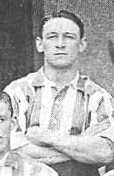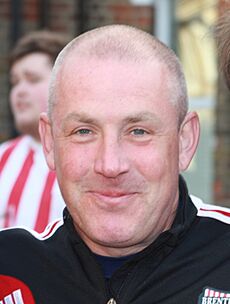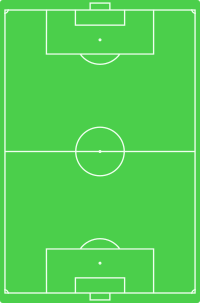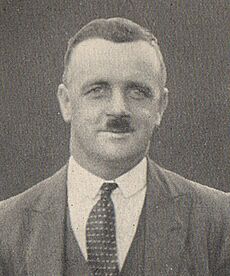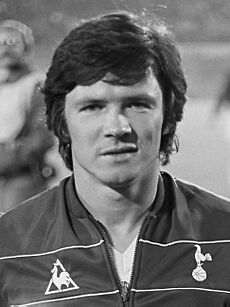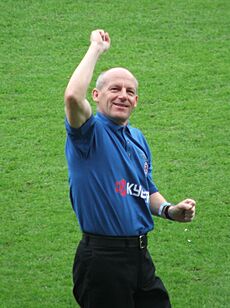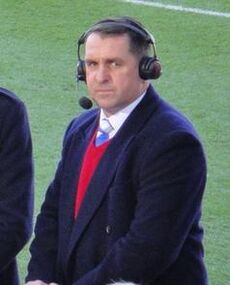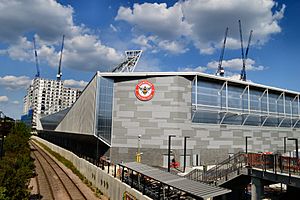History of Brentford F.C. facts for kids
Brentford Football Club is a professional football team from Brentford, London. The club started in October 1889. It was formed by local sports fans who wanted a lasting football or rugby club in their town. By 1896, Brentford had joined the London League. They moved up to the Southern League in 1898 and then joined The Football League in 1920.
Brentford's most successful time began when Harry Curtis became manager in 1926. They won promotions in 1933 and 1935, reaching the top division of English football for the first time. They finished in the top six of the First Division for three years in a row, making them one of England's best clubs. However, things started to go downhill in 1938, and by 1954, the club was back in the Third Division South.
After challenging for promotion in the mid-1950s, Brentford faced another decline. They were relegated to the new Fourth Division in 1962 and almost went out of business in 1967. Brentford moved between the Third and Fourth Divisions throughout the 1960s and 1970s. They finally settled back in the Third Division after winning promotion in 1978.
By 1986, Brentford had been in the Third Division since 1978. But when Steve Perryman became manager in 1987, the club got a new boost. Under his successor, Phil Holder, the club finally returned to the second division in 1992, after waiting 38 years. They were relegated right away. Except for three seasons in the fourth division (where they won two championships), Brentford stayed in the third division until 2014. After five failed playoff attempts in 19 years, the club was automatically promoted back to the second division. After two more failed playoff attempts in six seasons, Brentford finally won promotion to the Premier League in 2021 by winning the Championship play-off final.
Contents
- Club Beginnings
- Southern League Adventures
- World War I Football
- Joining The Football League
- The Harry Curtis Era
- World War II and After
- Decline and Financial Struggles
- Challenges and Promotions
- Financial Crises
- Recovery and New Heights
- Back to the Second Tier
- Near Misses and Relegation
- New Eras and Premier League
- Takeover and Promotions to the Premier League
- Premier League Era
Club Beginnings
How Brentford F.C. Started (1889)
In 1889, the town of Brentford, Middlesex, had a rowing club and a cricket club. People had tried to start football and rugby clubs before, but they didn't last. Then, a new sports ground opened on October 17, 1889. A week earlier, members of the rowing and cricket clubs met at a pub to decide how to use the new ground. They hoped to create a lasting football or rugby club.
On October 16, 1889, the rowing club members met again. They voted that the new club would play association football. They decided to call it "Brentford Football Club". The team's first colors were salmon, claret, and light blue, just like the rowing club. J. J. K. Curtis became the club's first captain. The club quickly found a home field behind the local offices at Clifden House in Brentford.
Early Games and First Wins (1889–1896)
On October 26, 1889, the club held its first practice game. On November 23, they played their first official match against Kew, which ended in a 1–1 draw. T. H. M. Bonell scored Brentford's first goal. For the rest of the 1889–90 season, they mostly played friendly matches. In the 1890–91 season, Brentford entered the West Middlesex Cup. Their first competitive game was a 6–0 loss to Southall.
In the 1892–93 season, Brentford joined a league for the first time, the West London Alliance. They moved to Benn's Field in October 1892. The team played very well, finishing first in the division without losing a single game. They won 10 out of 12 matches. Brentford won their first competition in the 1894–95 season, beating 8th Hussars 4–2 in the West Middlesex Cup final. It was also during this season that Brentford got their famous nickname, "The Bees". Friends of a player chanted "buck up Bs," and the local newspapers thought it meant "the Bees," and the name stuck.
Joining the London League (1896–1898)
Brentford continued to play cup and friendly matches until 1896. Then, the club was accepted into the Second Division of the London League. With many goals from Oakey Field and about 1,500 fans at home games, the Bees finished second. This earned them promotion to the First Division, as they lost only one match all season. The 1897–98 season was Brentford's best yet. They finished as runners-up in the London League First Division and won both the London Senior Cup and the Middlesex Senior Cup.
Southern League Adventures
Second Division (1898–1901)
Brentford's success in the London League led to them joining the Southern League Second Division for the 1898–99 season. Many key players left, including Oakey Field. The club moved to Cross Road. Brentford finished fourth in the division and played in the FA Cup for the first time. They lost their first FA Cup game to Clapton. After a so-so 1899–1900 season, the club became professional.
Everything went well for Brentford in the 1900–01 season. Now playing at Boston Park Cricket Ground, under manager William Lewis, the team changed a lot. Peter Turnbull was the Southern League's top scorer, helping the Bees win the Second Division title. Brentford earned a spot in the top division in July 1901 when another team dropped out.
First Division (1901–1913)
In 1901, the club became a limited company, and almost a whole new team was put together. Brentford finished 15th in the 1901–02 season and avoided relegation. Due to money problems, managers could only achieve mid-table finishes. In 1903, manager Dick Molyneux changed Brentford's colors to dark blue and gold stripes.
Brentford moved to Griffin Park, their first permanent home, for the 1904–05 season. The Bees reached the FA Cup third round for the first time in 1905–06. Despite 18 goals from Geordie Reid, Brentford finished last in the First Division in 1908–09 but were saved from relegation. In 1909, Brentford's colors changed again to gold shirts with blue sleeves. In 1912–13, Brentford was relegated after 11 seasons in the First Division.
Back in the Second Division (1913–1915)
Dusty Rhodes became player-manager for the 1913–14 Southern League Second Division season. Most professional players from the previous season were sold. Despite money shortages, Brentford finished 3rd. For the 1914–15 season, the club's travel money from the Southern League was cut. The future looked tough with fewer fans expected.
When Britain declared war on Germany in August 1914, it affected the club's plans. As the season went on, players left to fight or work in factories. By March 1915, only a few original players remained. The Bees managed a mid-table finish by using amateur and guest players. In July 1915, the Southern League stopped its competition for the duration of World War I.
World War I Football
Brentford played in the London Combination during World War I. The team struggled, finishing low in the division from 1915–16 to 1917–18. Many players were called up for war service. The club used many different players, with 42 players in 1915–16 and 58 in 1917–18. During this time, the club wore dark blue shirts with gold collars.
As the Hundred Days Offensive began in France and the 1918–19 season started, there was hope that the war would end soon. With many goals from Henry White, Jack Cock, and Fred Morley, Brentford won the London Combination title. After the war ended in November 1918, the club made a profit, which helped improve Griffin Park.
Joining The Football League
Last Southern League Season (1919–1920)
Brentford chose not to apply for the Football League for the 1919–20 season. Instead, they applied for the First Division of the Southern League, which they got. This was their first time at the top of the Southern League since 1912–13. Manager Fred Halliday signed almost a completely new team. The loss of Henry White's goals led to a 15th-place finish.
Early Football League Years (1920–1926)
In May 1920, Brentford and 20 other Southern League clubs joined the Football League. They became founding members of the Third Division for the 1920–21 season. The club's colors changed to white shirts and black shorts. Brentford's first Football League match was on August 28, 1920, against Exeter City, which they lost 3–0. Despite 18 goals from Harry King, the team finished 21st. They were allowed to stay in the league.
Archie Mitchell became player-manager in 1921. With Harry Morris scoring 17 goals, Brentford finished 9th in 1921–22. But key players left, leading to two mid-table finishes. Mitchell stepped down in December 1924, and Fred Halliday took over as manager for the third time. Halliday stayed for 1925–26, a season that, despite an 18th-place finish, showed promise with new forwards like Ernie Watkins. In 1925, Brentford's white shirts changed to the famous red and white stripes.
The Harry Curtis Era
Building a Strong Team (1926–1932)
In 1926, Harry Curtis became manager. Only 9 players from the previous season stayed. Despite mid-table finishes for three seasons, Curtis slowly rebuilt the team. He brought in good defenders like William Hodge and Alexander Stevenson, and forwards like Bill Berry. The 1929–30 season laid the groundwork for future success. The club set a national record by going unbeaten at home for 21 games. Important players like Jackie Foster and Billy Lane were signed. Brentford won a club-record 28 league matches but missed out on promotion. They finished 3rd and 5th in the next two seasons.
Promotions to the Top Divisions (1932–1935)
In 1932, Curtis made several key transfers that would send Brentford upwards. He brought in players like Jack Holliday, Billy Scott, and new captain Herbert Watson. The Bees easily won the 1932–33 Third Division South title. Jack Holliday scored a club-record 39 goals. The team did well in the Second Division, adding forward Charlie Fletcher. Brentford held a promotion spot for months but were just beaten by Preston North End.
In 1934, Curtis signed goalkeeper James Mathieson and defender George Poyser. The "Big Five" forward line (Scott, Holliday, Muttitt, Fletcher, and Hopkins) kept Brentford in the Second Division promotion spots for most of 1934–35. After reaching the top of the table on March 2, 1935, the Bees stayed there, winning the title and promotion to the First Division for the first time ever. Brentford also won the London Challenge Cup.
Top Division Glory (1935–1939)
After rising from the third division to the first in just three seasons, manager Harry Curtis kept his team together for the 1935–36 First Division season. Griffin Park's capacity was increased to 40,000, bringing in more money. After 15 matches, Brentford looked set for relegation. But new signings like David McCulloch and Bobby Reid helped turn things around. The Bees had the best form in all four divisions, losing only two of their last 23 matches. They finished in the club's highest-ever position of 5th.
Brentford continued to do better than expected in the 1936–37 and 1937–38 seasons, finishing 6th each time. They also reached the FA Cup sixth round for the first time. The club was at its peak between October 1937 and February 1938, holding the top spot in the First Division for 17 matches in a row. Brentford players like Duncan McKenzie and Billy Scott (who became the first full England international from Brentford) were called up for national teams.
The 1938–39 season marked the beginning of the end for Brentford's golden era. Older players were slowing down, and the club sold key players like McKenzie and McCulloch. While they made money from these sales, they spent less than half of it on new players. Six wins in 10 games from February to April 1939 helped Brentford avoid relegation. Young player Les Smith became the second Brentford player to play for England.
World War II and After
Despite the threat of war in August 1939, preparations for the 1939–40 season continued. Harry Curtis's main signing was new captain Tom Manley. The season only lasted three matches before Britain declared war on Germany, stopping competitive football.
Brentford played in wartime leagues, with many guest players and young amateurs. The main players from before the war also continued to play. Brentford's most memorable wartime moment was on May 30, 1942. Two goals from Les Smith gave the Bees a 2–0 win over Portsmouth in the London War Cup final at Wembley Stadium. In the final wartime season (1945–46), Brentford reached the FA Cup sixth round again.
Decline and Financial Struggles
Relegation and Harry Curtis's Last Years (1946–1949)
For the first season after World War II (1946–47), Brentford's team relied on older players from the 1939–40 squad. Many key players had left. New Scottish players joined, but the team's slump continued, and the Bees were relegated from the First Division.
After barely avoiding another relegation in 1947–48, manager Harry Curtis announced that the 1948–49 season would be his last. His long-time trainer also retired. Jackie Gibbons became player-manager in February 1949, ending Curtis's nearly 23-year reign. The season ended with a poor 18th-place finish. However, a new club record attendance of 38,678 was set for an FA Cup game against Leicester City.
Money Problems and Another Relegation (1949–1954)
Despite finishing 9th twice in a row in 1949–50 and 1950–51, manager Jackie Gibbons had done well with little money to buy players. He signed low-cost players like Ken Coote and Billy Dare, who would play over 200 games for the club. The team often lacked goal scorers during Gibbons' time as manager.
Gibbons resigned before the 1952–53 season. Assistant manager Jimmy Bain took over temporarily. Brentford struggled near the relegation spots. Tommy Lawton became player-manager in January 1953 and guided Brentford to a 17th-place finish. But after only one win in the first six games of the 1953–54 season, he resigned. Player Fred Monk took temporary charge before Bill Dodgin Sr. was appointed. By then, the damage was done, and Brentford was relegated to the Third Division South on the final day of the season.
Challenges and Promotions
Back in the Third Division South (1954–1957)
Being relegated to the Third Division South meant the 1954–55 season was Brentford's first in the bottom division in 21 years. Money from selling a player was used to pay off debts. Manager Bill Dodgin Sr. had no budget for new players. However, the youth team, led by Alf Bew, produced many talented young players. Forwards Jim Towers, George Francis, and goalkeeper Gerry Cakebread came through the youth system. After a mid-table finish in 1954–55, Jim Towers' 22 goals in the 1955–56 season helped Brentford finish 6th. George Francis became Towers' partner in 1956–57, scoring 24 goals. Manager Dodgin announced he would leave the club in March 1957.
"The Terrible Twins" (1957–1961)
Before the 1957–58 Third Division South season, former Brentford player Malky MacDonald became manager. The "Terrible Twins" strike partnership of Jim Towers and George Francis was amazing, scoring nearly 200 goals in MacDonald's first four seasons. Towers scored 37 goals in 1958–59, making him the Third Division's top scorer. MacDonald was able to field a consistent team in the late 1950s and early 1960s.
Things started to go wrong in the 1960–61 season. The team played poorly, and the club had debts of £50,000. In a strange move, Brentford's main kit was changed to amber shirts with a blue 'V' for one season. Towers and Francis asked to be sold in February 1961. Brentford finished 17th, and many long-serving players were released.
Financial Crises
The 1967 Crisis
By January 1967, Brentford had spent a lot on player transfers but earned little back. Attendance had dropped by half, and the club was losing £400 a week. The chairman announced in December 1966 that he would sell his share in the club. There had been talks with Queens Park Rangers about sharing Griffin Park. On January 19, 1967, news broke that Brentford's rivals, Queens Park Rangers, would move into Griffin Park, and Brentford Football Club would cease to exist. It turned out that the rest of Brentford's board had not been told about this plan.
After a month of fan protests and donations, a group led by Ron Blindell took over the chairman's shares on February 23, 1967. They also guaranteed a large loan. The next day, Blindell took control of the club. Manager Billy Gray left, and Jimmy Sirrel took over. Brentford's form improved, and they finished the 1966–67 season in 9th place. The Bees also won the London Challenge Cup.
"Brentford Borough" Plan (1967–1968)
The Brentford staff knew they weren't out of trouble yet. The club had a £100,000 debt that needed to be paid by June 30, 1968. Manager Jimmy Sirrel had only 16 players and had to use loan players. He did a great job, keeping the team around 6th place by November 1967. However, Brentford then started to drop down the table.
On March 11, 1968, chairman Ron Blindell announced plans to leave Griffin Park and move to Hillingdon's stadium. Queens Park Rangers had offered £250,000 for Griffin Park, which would clear Brentford's debts if they moved. The name "Brentford Borough FC" had even been chosen for the new club. But once again, Brentford was saved at the last minute. A former director gave the club a large interest-free loan. Despite terrible form in the second half of the 1967–68 season, Brentford only dropped to 14th place.
Recovery and New Heights
Recovery and Promotion (1969–1972)
Brentford topped the table on the first day of the 1968–69 season, but then fell back to mid-table. Manager Jimmy Sirrel was able to sign more players on free transfers. However, the sale of a key player left Sirrel with only 13 fit players by mid-October 1969. Despite doing well to keep Brentford in the promotion race, Sirrel left for Notts County in November 1969. Frank Blunstone became manager in December. New signings like Brian Turner and Roger Cross were important. Brentford missed promotion by three points.
The 1970–71 season is remembered for a good run to the FA Cup fifth round. This helped the club make a £20,000 profit, which paid off a large loan. With goals from John O'Mara, Brentford started the 1971–72 season strongly. They were at the top of the Fourth Division for much of the time between August 1971 and January 1972. Brentford secured promotion back to the Third Division with two games left in the season.
Relegation, Stability, and Promotion (1972–1977)
Despite making a profit, manager Fred Blunstone had to work with a small budget for the 1972–73 season. After five games, Brentford were in 2nd place. But in September 1972, top scorer John O'Mara was sold for a club record £50,000. Soon after, captain Bobby Ross also left. The board only allowed Blunstone to spend a small amount on new players. Brentford slipped into the relegation zone and were relegated on the final day of the season. Frank Blunstone resigned in July 1973.
Under new managers Mike Everitt and John Docherty, Brentford stayed in mid-table in the Fourth Division during the mid-1970s. A poor start to the 1976–77 season led Docherty to resign. Bill Dodgin Jr. took over. Dodgin's new signings strengthened the team, which was led by forwards Steve Phillips and Andrew McCulloch. Even though a key player was sold late in the 1977–78 season, Brentford secured promotion back to the Third Division with a 4th-place finish. Phillips' 32 goals made him the top scorer in the Football League.
Stability in the Third Division (1978–1986)
Managers Bill Dodgin Jr., Fred Callaghan, and Frank McLintock all led Brentford in the Third Division between 1978 and 1986. Under Callaghan, the club had three top-9 finishes in a row from 1981 to 1983. Many notable players played for the club during this time, including Bob Booker and Chris Kamara. Brentford reached its first major cup final in the 1984–85 season. They played against Wigan Athletic in the 1985 Football League Trophy Final at Wembley Stadium. Brentford lost 3–1.
Back to the Second Tier
Building a New Core (1986–1990)
Frank McLintock began his third full season as Brentford manager in 1986–87. He had slowly improved the club's league position. Before the season, assistant manager John Docherty left, and McLintock replaced him with former England international Steve Perryman. Poor results led to McLintock's departure in January 1987. Steve Perryman took over as player-manager. Perryman's Brentford managed to finish in mid-table. Brentford came close to the playoff spots in 1987–88 and 1988–89. The latter season was also memorable for FA Cup and Football League Trophy runs.
After a forgettable 1989–90, Perryman resigned. While he didn't bring immediate success, his signings of players like goalkeeper Graham Benstead, midfielders Keith Jones, and forwards Dean Holdsworth and Gary Blissett, along with homegrown defenders, would help Brentford in the future.
Rise to the Second Tier (1990–1993)
Phil Holder took over as Brentford manager just 10 days before the 1990–91 season. In his first season, he led the Bees to the Football League Trophy area finals and into the 1991 Third Division playoffs. They lost narrowly to Tranmere Rovers. This was the first of many failed playoff campaigns for the club.
The 1991–92 season was arguably Brentford's best since the Harry Curtis era. 11 wins from the first 16 matches put the Bees at the top of the Third Division. Six wins from the final six matches saw Brentford win the Third Division championship on the last day. This secured second-tier football for the first time since the 1953–54 season. Much of this success was due to striker Dean Holdsworth, who scored 38 goals.
Phil Holder's preparations for the 1992–93 season in the newly named First Division were hit hard. Dean Holdsworth joined Wimbledon for a large fee in July 1992, and captain Terry Evans suffered a long-term knee injury. The season started poorly, but the team improved. However, everything fell apart in the New Year, leading to relegation back to the third tier after a 4–1 loss on the final day.
Near Misses and Relegation
Rebuilding and Playoff Heartbreak (1993–1997)
The 1993–94 season was a time of rebuilding for Brentford under new manager David Webb. Nicky Forster joined the team in June 1994. Together with Robert Taylor, their goals helped Brentford reach the top of the Second Division midway through the 1994–95 season. Brentford competed for automatic promotion but lost a key match. They then lost on penalties in the 1995 Football League playoffs.
After a slow start to the 1995–96 season, things improved in 1996–97. Carl Asaba became one of the top strikers, scoring 24 goals. Brentford was at the top of the table for much of the season until March 1997. The team was weakened by the sale of Forster. Four losses in the final four games dropped Brentford to 4th place and into the playoffs. They beat Bristol City in the semi-finals but lost to Crewe Alexandra in the 1997 Second Division playoff Final at Wembley Stadium.
Financial Crisis, Takeover, and Recovery (1997–2002)
Less than a week before the 1997–98 season, a group led by manager David Webb bought most of the club's shares. Webb then stepped down as manager. The new players brought in were not good enough. Webb's replacement, Eddie May, was sacked in November, and Micky Adams became manager. Despite new signings, Adams also struggled, and Brentford was relegated to the Third Division on the final day.
In June 1998, former Crystal Palace chairman Ron Noades took over Brentford. He made big changes, becoming chairman-manager himself. Excellent home form, expensive new players, and a 16-match unbeaten run helped the Bees win the 1998–99 Third Division championship on the final day. The 1999–00 and 2000–01 seasons were forgettable back in the Second Division. Noades resigned as manager in November 2000. Brentford reached the 2001 Football League Trophy Final under Ray Lewington but lost 2–1.
Steve Coppell became manager in May 2001. The team started strong, becoming promotion contenders. To get automatic promotion, Brentford needed to beat Reading on the final day. They took the lead but were held to a draw, forcing them into the 2002 Second Division playoffs. They beat Huddersfield Town in the semi-finals, but Stoke City won the final 2–0.
New Eras and Premier League
"The Great Escape" and "Two-Bob" Team (2002–2006)
Less than a month after the 2002 playoff final loss, Steve Coppell quit as manager. Due to financial problems, Coppell's replacement, Wally Downes, had an inexperienced team. The club barely avoided going out of business in August 2002. The 2002–03 season ended in mid-table. In March 2003, Noades quit, and control went to the supporters' trust, Bees United. More poor form followed in 2003–04, leading to Downes' sacking. Former Barnet manager Martin Allen took over and immediately turned things around, achieving "The Great Escape" from relegation on the final day.
Martin Allen built a "low-cost" team of experienced players, free transfers, youngsters, and loan players. He led Brentford through two exciting seasons in the newly named League One. In 2004–05, Brentford reached the FA Cup fifth round and made it to the 2005 League One playoffs, but lost in the semi-finals. The 2005–06 season saw another FA Cup fifth-round run. However, selling a key player weakened the team. Too many draws late in the season led to a 3rd-place finish and another playoff semi-final defeat. After this, the manager quit due to money issues, and key players were sold. However, in January 2006, the supporters' trust, with help from a fan named Matthew Benham, bought Ron Noades' shares. This secured the future of Griffin Park.
Relegation and Return to League One (2006–2009)
Leroy Rosenior became Brentford manager in June 2006. Despite a seven-match unbeaten start to the 2006–07 season, the team struggled. Rosenior was sacked in November 2006. Brentford's relegation was confirmed on April 9, 2007. They finished last in League One, the first time the Bees had finished bottom of a Football League division. Despite relegation, the club's finances improved after Matthew Benham paid nearly £3 million to take over some of the club's debts in January 2007.
Former England international Terry Butcher became manager on April 24, 2007. Despite a good start to the 2007–08 season, terrible form led to Butcher's departure in December 2007. Assistant manager Andy Scott took over and turned things around. Scott improved the team for the 2008–09 season. By December 2008, Brentford was in the automatic promotion spots. The Bees won the League Two title after winning their second-to-last match of the season.
Takeover and Promotions to the Premier League
Consolidation and Championship Promotion (2009–2014)
Before the 2009–10 League One season, it was announced that supporter Matthew Benham would invest a lot of money over five years. Brentford finished 9th. The 2010–11 season was memorable for cup runs. They reached the League Cup fourth round and the 2011 Football League Trophy Final, which they lost 1–0. In March 2011, Benham agreed to invest £1 million a year for at least three seasons. Uwe Rösler became manager in June 2011, and Mark Warburton became sporting director. In June 2012, Benham became the main owner of the club, owning 96% of the shares.
Brentford came very close to automatic promotion to the Championship on the final day of the 2012–13 season. They lost 1–0 to Doncaster Rovers, who only needed a draw to go up. This was similar to the final-day match against Reading 11 years earlier. The Bees recovered to beat Swindon Town on penalties in the 2013 playoff semi-finals, but lost 2–1 in the final. The 2013–14 season started slowly, but after a team talk, Brentford went on a club-record 19-match unbeaten run. Mark Warburton continued Rösler's good work and led Brentford to a second-place finish and automatic promotion to the Championship. Earlier in 2014, Benham became the full owner of the club. His funding was key to Brentford's rise from League Two in 2007 to the Championship in 2014.
The Championship and Premier League Promotion (2014–2021)
Brentford surprisingly finished 5th in their first season back in the second tier since 1992–93. However, they were beaten by Middlesbrough in the 2015 playoff semi-finals. After this, the club changed its management and recruitment. Warburton left and was replaced by Marinus Dijkhuizen. Dijkhuizen lasted only 9 matches before Lee Carsley took over temporarily. Dean Smith was appointed in November 2015. Smith helped Brentford stay in the Championship with two top-10 finishes. At the end of the 2015–16 season, the club decided to close its academy and development squad. Instead, they started a "B team" to develop players, believing they couldn't outspend rivals but could out-think them. The academy reopened in July 2022.
After a stable season, Dean Smith's replacement, Thomas Frank, led Brentford to the 2020 Championship play-off final. They lost 2–1 to rivals Fulham. At that time, 9 out of 9 failed playoff campaigns was a national record. In 2020, the club moved out of Griffin Park, their home for 116 years. They moved into the Brentford Community Stadium, a new 17,250-seat stadium. Brentford finished third again in the 2020–21 regular season. They then won promotion to the Premier League by beating Swansea City 2–0 in the 2021 Championship play-off final.
Premier League Era
Under head coach Thomas Frank, Brentford finished 13th in 2021–22, 9th in 2022–23, and 16th in 2023–24 in their first three Premier League seasons. In the 2022–23 season, the club was still in the running for a European spot on the final day. They finished above all their West London rivals in the league for the first time since 1938–39.


